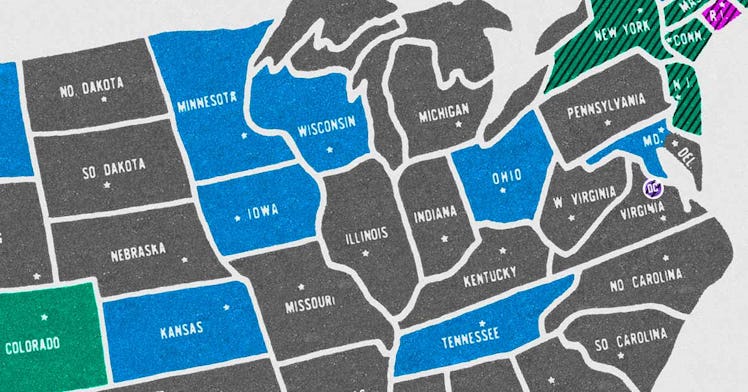This Map Shows Every State’s Paid Leave Laws — And It’s Dismal
American parents continue to suffer without a national paid parental leave law, but a few states have added it on their own.

The time immediately after birth or adoption is a crucial one for parents and children, and because of that, most countries across the world provide some form of paid prenatal leave, parental leave, or federal paid family leave for their citizens. But not us.
The United States stands alone in being the sole nation in the OECD that guarantees exactly zero federal paid parental leave to its citizens. And despite the best efforts of some federal lawmakers, it’s been those in just a few states who’ve actually been successful in giving more people what should be a universal benefit.
Here’s what you need to know about the state of parental leave in the U.S., from the inadequate law on the federal books to the places that are stepping up to help new parents.
What does federal law say about family leave?
There is one federal leave law on the books. The Family and Medical Leave Act, passed in 1993, guarantees “eligible employees of covered employers to take unpaid, job-protected leave for specific family and medical reasons with continuation of group health insurance coverage under the same terms and conditions as if the employee had not taken leave.” Those reasons include birth, adoption, and foster placement of a new child.
“Covered employers” are employers that are either public agencies (at any level of government), K-12 schools (public or private), or private-sector employers who employed 50 or more people in 20 or more workweeks. That’s a complicated way of saying that smaller businesses—a favorite buzzword of certain political actors—don’t have to let their employees take time off when they have a kid.
“Eligible employees” are those who have had their job for at least 12 months and worked for at least 1,250 hours in the previous year at a location where the employer has at least 50 employees within 75 miles can claim leave under FMLA.
It matters a lot that the leave provided for by the FMLA is unpaid. For working-class families, the job-protected leave is nice, but it can’t be taken because, well, people can’t afford to not get paid.
All it means is that you can’t lose your job or your employer-provided health insurance while you’re out. Taking the full 12 weeks means giving up 12 weeks of pay, nearly a quarter of one’s annual wages. It’s practically impossible for working people to do that, further limiting the number of people who can take advantage of the time.
The refusal to allocate substantial funding and linguistic knot-twisting in the bill reveals why the FMLA is so inadequate. When the vast majority of people can’t afford to take the leave offered on a federal basis, even if they qualify under the stipulations, it’s not really a law that helps people.
How many states provided more unpaid leave?
Twenty-one states, the District of Columbia, and Puerto Rico have extended unpaid leave beyond the limitations imposed by the FMLA, according to HR software company Paycor. Here are a few examples:
- In Iowa, companies with four or more employees must offer eight weeks of unpaid leave regardless of how long an employee has worked there.
- In Maine, companies with 15 or more employees have to offer ten weeks of unpaid leave to their employees.
- In Montana, all female employees are entitled to a “reasonable leave of absence for pregnancy.”
In all of the states that have only extended more unpaid leave to their citizens, the problem of people being unable to afford to take time off remains. That’s why the real MVPs are the state legislators who’ve managed to get paid parental leave passed into law.
Which states have paid parental leave?
A handful of state and local governments have stepped up to ensure that new parents within their confines receive this rather obvious benefit, and as time passes, barring a federal leave policy being passed under the Biden Administration, you should expect more states to step up to the plate and offer the benefit.
California, Rhode Island, New York, New Jersey, Washington, Massachusetts, Connecticut, Oregon, Colorado, the District of Columbia, and Puerto Rico all guarantee parents leave within one year of birth or adoption placement for some amount of time at some income level. The particulars in each state vary—notably, Puerto Rico’s benefit only applies to moms for four weeks before birth and four weeks after—but in all, there’s some kind of program to avoid forcing new parents who spend precious time with their kids to miss out on the income that makes it possible to take care of your family financially.
This article was originally published on